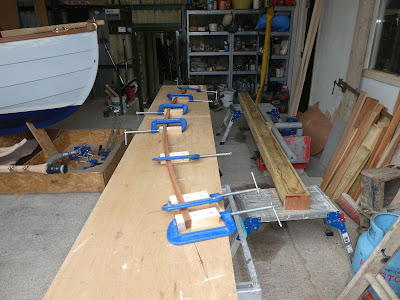Because
of the challenges I have faced in producing a deck to satisfy my perceived
design requirements, it has been quite some time since my last post,
however I can now report that the deck
has been laid, caulked and rubbed down.
Since
the start of the build, I have visualised how I wanted the deck to look and invested
some time in marking out the layout in chalk, this allowed me to make adjustments
in the design by simply rubbing off any offending lines to alter the set out. I
felt it absolutely essential that the teak strips be swept to follow the lines
of the boat with the exception of the deck forward of the cabin which, I laid
parallel to the sides of the anchor compartment cover.
The amidships
area around the cabin required the teak strips (45mm x 6mm) to be bent to a fairly
tight radius. At first I tried to achieve this by cold bending, but found that
the radius was beyond the limit from which they were prepared to bend.
Following further research I discovered that there were conflicting views as to
whether teak could be steam bent, especially given that the strips required
edge bending in the horizontal plane with the 45mm face uppermost. I decided to
build a steam box and a jig constructed to the appropriate radius. Despite
multiple attempts by varying the time the material spent in the steam box, I
could not achieve the required radius without the material buckling, even by
using a system of multiple clamps to hold the strips flat to the jig base. I
concluded that the only option was to purchase some additional wide boards and
cut each individual deck strip to the required radius; this proved to be time
consuming and produced a high percentage of waste material, however I achieved
the results I aspired to. The teak strips were glued down with epoxy as I had
done previously with the cockpit sole. The 5mm wide joints were then primed
with Sika Flex 290 DC primer before filling with Sikflex 290 DC Pro in black. I
allowed about three weeks for the product to fully cure before sanding the
surface off flush. Time was occupied during the interim period by painting and
varnishing completed surfaces.
The steam box.
I constructed the steam delivery pipe in 15mm copper tube with
soldered
fittings then used insulation to minimise temperature drop
Edge bending a
teak planking strip. I did achieve a
gentle bend to this aft plank:
Note the
timber strips screwed through into the jig base to prevent buckling
You can see the
tighter radius amidships
The aft set
out
I put
the steam box to good use to steam bend the sapele toe rails. Following two
hours in the box, they bent easily around the jig. I over compensated the
radius to allow for spring back when they were removed from the jig the following
day.
Steam bending
the toe rails. I manufactured them to the finished tapered
profile then
cut corresponding tapered blocks for the jig
Completed teak
decking and toe rails.









